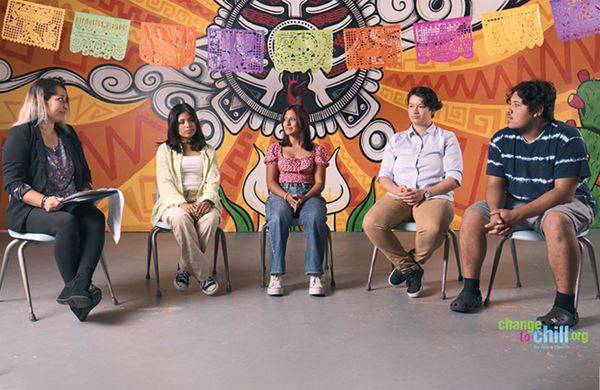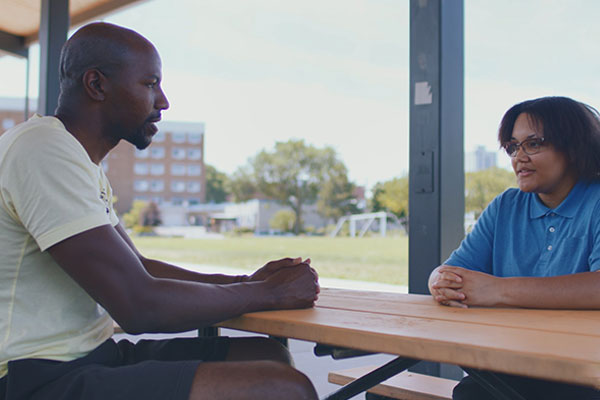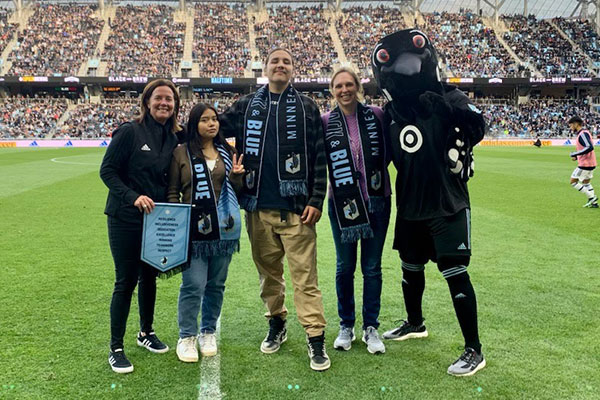Change to Chill supports youth mental health

Adalinda Estrada, a counselor at El Colegio High School, engages four Latinx students in a conversation about their experiences with mental health and well-being. Photo credit: Allina Health.
Change to Chill’s website contains a wide range of youth-focused articles, videos, and resources focused on everyday mental health and stress management for teens and those who care for them. But Change to Chill, started in 2013 through Allina Health’s Community Health Initiatives, is much more than a website. Recognizing that stress impacts each person differently based on their identities, Change to Chill formed a unique partnership with Hennepin County Public Health and several community organizations to ensure they were best supporting youth from diverse identity groups. In 2021, these partners developed new identity-focused content to give youth a sense of belonging, pride in their identities, and culturally relevant resources to support their mental health.
Hennepin County Public Health’s Health Promotion Specialist Catherine Rude initiated the partnership with Change to Chill in the summer of 2020 to better reach youth in Hennepin County most impacted by the pandemic and the murder of George Floyd. Sydney Hobart, who serves as the Change to Chill Coordinator at Allina Health, explained, “Change to Chill talks a lot about day-to-day stressors. But it's meant to be broad, and does that really speak to everybody's experience? How can we provide tailored resources and information for youth who do identify as Black or African American, Hispanic or Latinx, Native or Indigenous, and/or LGBTQ?”

Jamil Stamschror-Lott, a licensed independent clinical social worker (LICSW) and CEO and Co-Founder of Creative Kuponya, engages a student in their experiences with mental health and well-being as a Black teen. Photo credit: Allina Health.
The first step: engaging community consultants
The first step was to begin building relationships with "community consultants” who identify as or work with local youth who identify as Black/African American, Latinx/Hispanic, Native American/Indigenous, or LGBTQ. While the community consultants’ roles have grown and evolved since 2020, their purpose remains the same: to serve as an ongoing, trusted bridge to their communities. After the consultants reviewed existing content and co-led a series of live webinars, the team decided to broaden and deepen their reach by focusing on more accessible recorded webinars and developing new identity-focused pages on the website to fill the gaps that community consultants had identified.
Over the past year, community consultants from Creative Kuponya, El Colegio High School, Indigenous Peoples Task Force, and Annex Teen Clinic created written content and videos for youth in their respective identity groups. Khadijah Cooper is education director at Annex Teen Clinic in Robbinsdale, which provides clinical services and education around sexual health for youth, including many who identify as Black, Indigenous, People of Color (BIPOC), and LGBTQ. Annex Teen Clinic worked on developing new content for an LGBTQ identity page, and Khadijah described what she wanted an LGBTQ young person to think after visiting the page: “I feel seen and I feel really good. I feel positive about my identity. I think with the partnership with Allina Health, we were definitely able to do that.”
Youth produce content for youth
Providing a place where youth feel seen and affirmed is a common theme across Change to Chill’s latest wave of identity-focused work, as is representation. Suzanne Nash, First Medicines Program Manager with Indigenous Peoples Task Force (IPTF), shared that IPTF felt that content for Native youth should be created by youth. So she turned to a group of young people to create a series of videos about how they use the first medicines of cedar, sage, tobacco, and sweetgrass to support physical, mental, emotional, and spiritual health.Reflecting on the experience, Suzanne said, “I think they learned a lot, and they’re pretty proud that they did it." She went on to say that having a page created by and for youth that talks about traditional medicines and practices that until as late as the 1978 passage of the American Indian Religious Freedom Act could be prohibited by law feels historic. "They’re working to be inclusive. They’re working to change history. They’re on the forefront of it. I’m grateful,” she concluded of the Change to Chill team.

Two youth partners from Indigenous Peoples’ Task Force were honored for their work in the community at a Minnesota United game in October 2022. Photo credit: Allina Health.
Moving Change to Chill into action with youth
Hennepin County and Allina Health have leveraged their partnership to ensure that the rich resources developed through community partnerships get into the hands of school staff and youth agencies to use with teens. The response from staff looking for youth mental well-being supports has been tremendous. Change to Chill offered two online trainings in 2022, which have so far reached over 800 caring adults via the live sessions and recordings. Hennepin County also created a free resource, “A Guide to Creating Calm Spaces in Schools,” to provide practical guidance for school staff on how to create a calm kit or space that aligns with their needs and resources. Find a link to that guide and the trainings in the Resources section below.
Going forward: mental health matters for adults too
The increasingly diverse range of content on Change to Chill’s website shows that there are many healthy options for teens to manage stress in ways that resonate and align with their identities and needs. But the partners involved believe that mental health matters for everyone, every day, not just for young people and not just in times of crisis. Sydney noted, “We need to make sure that there is messaging and empowerment that these are things for adults too, and that we're creating and supporting spaces in which that happens.” Her team at Allina Health starts every team meeting by brainstorming “three good things” as a small way to practice gratitude and shift focus to the positive. So whether you care for or work with young people or not, check out Change to Chill’s website, peruse the many resources available, and take some time today to practice taking care of your mental health.
Resources
Check out and browse all the free resources on Change to Chill.
Find training on new BIPOC and LGBTQ+ resources, the guide to creating calm spaces in schools, and other youth mental well-being resources on the Public Health Promotion website.
Learn more about Change to Chill’s community partners:
Check out Allina Health’s other Community Health Initiatives focused on mental well-being: